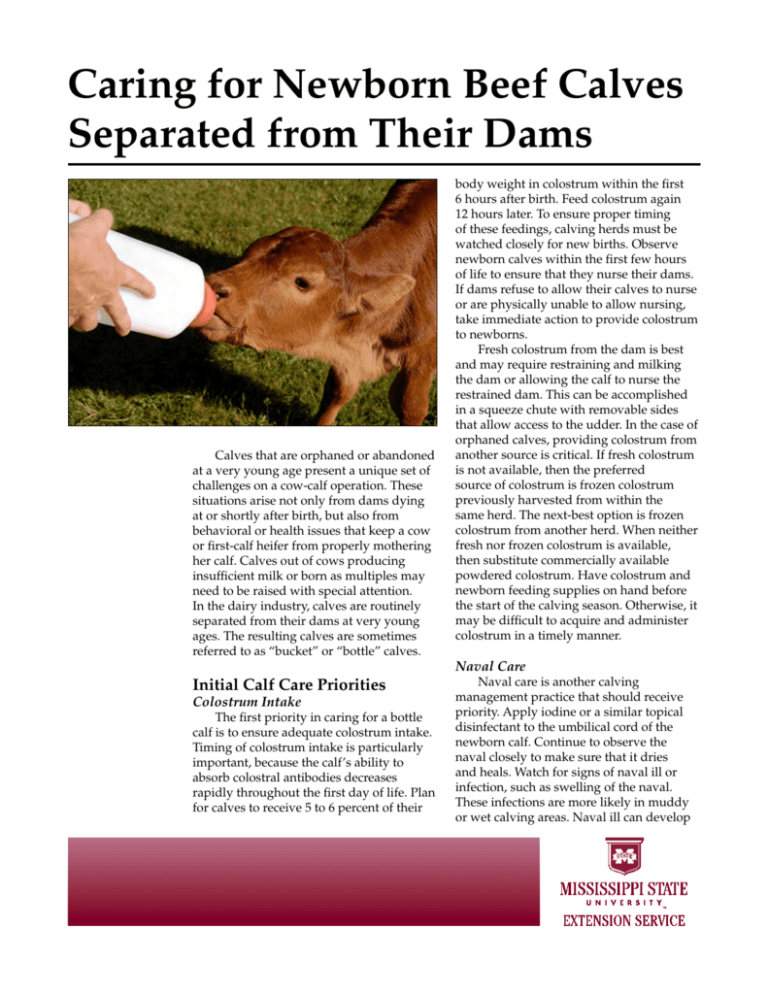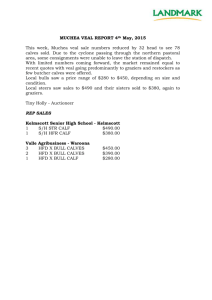
Caring for Newborn Beef Calves
Separated from Their Dams
Calves that are orphaned or abandoned
at a very young age present a unique set of
challenges on a cow-calf operation. These
situations arise not only from dams dying
at or shortly after birth, but also from
behavioral or health issues that keep a cow
or first-calf heifer from properly mothering
her calf. Calves out of cows producing
insufficient milk or born as multiples may
need to be raised with special attention.
In the dairy industry, calves are routinely
separated from their dams at very young
ages. The resulting calves are sometimes
referred to as “bucket” or “bottle” calves.
Initial Calf Care Priorities
Colostrum Intake
The first priority in caring for a bottle
calf is to ensure adequate colostrum intake.
Timing of colostrum intake is particularly
important, because the calf’s ability to
absorb colostral antibodies decreases
rapidly throughout the first day of life. Plan
for calves to receive 5 to 6 percent of their
body weight in colostrum within the first
6 hours after birth. Feed colostrum again
12 hours later. To ensure proper timing
of these feedings, calving herds must be
watched closely for new births. Observe
newborn calves within the first few hours
of life to ensure that they nurse their dams.
If dams refuse to allow their calves to nurse
or are physically unable to allow nursing,
take immediate action to provide colostrum
to newborns.
Fresh colostrum from the dam is best
and may require restraining and milking
the dam or allowing the calf to nurse the
restrained dam. This can be accomplished
in a squeeze chute with removable sides
that allow access to the udder. In the case of
orphaned calves, providing colostrum from
another source is critical. If fresh colostrum
is not available, then the preferred
source of colostrum is frozen colostrum
previously harvested from within the
same herd. The next-best option is frozen
colostrum from another herd. When neither
fresh nor frozen colostrum is available,
then substitute commercially available
powdered colostrum. Have colostrum and
newborn feeding supplies on hand before
the start of the calving season. Otherwise, it
may be difficult to acquire and administer
colostrum in a timely manner.
Naval Care
Naval care is another calving
management practice that should receive
priority. Apply iodine or a similar topical
disinfectant to the umbilical cord of the
newborn calf. Continue to observe the
naval closely to make sure that it dries
and heals. Watch for signs of naval ill or
infection, such as swelling of the naval.
These infections are more likely in muddy
or wet calving areas. Naval ill can develop
even when the naval is disinfected shortly after birth
and ground conditions are dry. An infected naval
typically appears swollen and may be painful to the
touch. Treat an infected naval immediately. Consult a
veterinarian for treatment protocols.
Protection
Provide calves with clean, well-ventilated pens
and shelter from the weather. Calf hutches can be
purchased or barn pens used to house bottle calves.
Individual penning can help prevent calves from
sucking one another and reduce the spread of disease.
It also facilitates individual monitoring of calf feed
intake and feces consistency as signs of calf health.
Allow 15 to 20 square feet of barn space for calves with
access to an outdoor lot and 20 to 30 square feet of
barn space for those without outdoor lots. Mississippi
State University Extension Publication 2558 Beef Cattle
Calving Management provides additional details about
processing newborn beef calves.
Very young calves raised on bottle or bucket
feedings are generally more vulnerable to predators
than heavier, older cattle. Without the close connection
to a dam in the herd, bottle or bucket calves may
separate themselves from the herd on a frequent
basis. This leaves them vulnerable to predator attacks,
and predators may be particularly attracted to the
herd during calving season with the presence of
afterbirth and new calves. Consider penning bottle
calves in a more protected area such as a well-fenced
pen with a mature cow until they grow to a size and
thriftiness that allows them to better escape from or
defend against predators. Extension Publication 2661
Predator Control on Beef Cattle Operations provides more
information on this topic.
Feeding the Young Calf
For the first few months of life, bottle calves
must be either artificially reared by humans on milk
replacer diets or grafted onto nurse animals. These
young calves are not yet mature ruminants, so they
need a milk-based diet. A calf needs to consume
approximately 8 percent of its birth weight in milk or
milk replacer each day. Offer bottles twice daily in two
equal feedings. Follow feeding directions on product
labels. As the calf grows, keep the amount of milk
replacer constant, but also offer calf starter feeds and
good quality hay as its appetite increases. Make clean
water available for the calf, as well.
Grafting to a Nurse Cow
Successful grafting of a calf onto the side of a
lactating cow eliminates the labor and expense of bottle
feeding. Besides providing a milk source for the calf, it
also gives the calf protection from predators. Grafting
a calf onto a beef cow that has lost her calf or another
nurse cow (often a dairy breed) purchased specifically
for such use requires management and patience.
Grafting may also be needed in cases in which the dam
initially refuses to allow her own calf to nurse. This
may be more common in females that calved for the
first time or dams that gave birth to multiples.
Start by penning lactating cows and newborn
calves separately from the rest of the herd in a space
that allows the calf to interact closely with the cow to
which grafting is being attempted. Provide adequate
shade and water in the pen, along with forages or
other feedstuffs for the cow. For best results when
introducing the cow and calf, do not bottle feed the
calf to satiation immediately before trying to get it to
suckle the prospective nurse cow. A tight-bagged (fulluddered) cow and a hungry calf are more likely to
result in successful grafting.
When applicable, rub or tie the skinned hide (skin
over the back along with the tail) of the nurse cow’s
dead calf onto the grafted calf to transfer scent and
encourage the cow to accept the new calf. Afterbirth
and commercial products consisting of synthetic
pheromones also can help in grafting. Using these
scents may be helpful during the first 2 to 3 days but
not much after that period.
The cow and calf may be too distracted by human
presence to nurse or bond when first introduced.
Allow them time alone together without distraction,
and then either observe them at a distance undetected
or check them later for signs of nursing, including a
full belly on the calf and slick teats or reduced udder
filling on the cow.
Initially give the nurse female an opportunity to
accept the calf without restraint, but do not wait too
long for nursing to occur before relying on restraint.
It is critical that newborn calves receive adequate
colostrum and nutrients in early life. Also, dehydration
is a risk that must be addressed through forced feeding
situations if necessary. If the cow repeatedly kicks at
or butts the calf and does not allow it to nurse when
unrestrained, physically restrain the nurse cow in a
squeeze chute with the bottom sides removed so the
calf can nurse twice a day. Repeat until the cow claims
the calf willingly.
If the nurse female has undergone a difficult
birth or is stressed from losing her calf, use extra care
in handling her, and observe her closely for signs of
distress or health problems. It is possible that even
when a nurse female accepts a grafted calf, she may
not lactate well enough to support the calf. In some
cases, the cow may dry off (discontinue lactation). Do
not assume that a suckling calf is getting adequate
nutrients through nursing. Closely monitor the calf’s
weight and condition, and supplement additional
nutrients as needed.
Milk Replacer Diet
In the absence of a nurse cow, use a milk replacer
that contains at least 22 percent crude protein and 15
percent fat. Mix milk replacer with warm water to
better dissolve the product and make it more attractive
to the calf. If a hot water source is not available close
to the feeding site, use a thermos or other insulated
container to transport warm water to the feeding site.
Then, mix the warm water and milk replacer powder
together when ready to feed the bottle. Keep the
temperature of the mix consistent between feedings
and not more than 100 degrees Fahrenheit. Also, use
the same amount of milk replacer in the mix each
feeding. Be sure to thoroughly mix the powder and
water by stirring or shaking to dissolve all of the
powder into the mixture.
Use separate bottles for each bottle calf to limit
risk of disease spread. Sanitize all feeding equipment
after each meal. To protect human health, particularly
that of susceptible young children, keep bottle feeding
supplies out of human food preparation areas.
Although a calf may instinctively nurse its mother,
it may need to be taught to drink from a bottle. Start
by inserting one or two fingers into the calf’s mouth.
As the calf begins to suck, insert the bottle nipple in its
mouth. It may be necessary to straddle or stand beside
the standing calf and support its head upward while
the calf is backed against a solid fence, wall (corner
is best), or vehicle. This head position will also help
close the esophageal groove present in young calves
and shunt milk past the rumen and directly to the
abomasum (“true stomach”) instead.
It may take a while to get lethargic or ill calves
to actively suck a bottle. When possible, spend the
additional time to get a calf started on a bottle before
resorting to a forced infusion of feeding liquid. But
if a calf still refuses to take a bottle, a stomach tube,
also known as an esophageal feeder, can be used to
infuse milk replacer directly to the calf’s stomach.
Take extreme care to ensure that the tube is in the
esophagus and not the windpipe. Listen to make sure
that breathing sounds are not coming from the tube.
Sometimes, infusion of milk replacer into the stomach
will stimulate a calf’s appetite. Weak calves may
Stomach tube.
require smaller and more frequent feedings. Continue
to monitor calves for signs of unthriftiness such as
poor growth, scours, and a “pot-bellied” appearance.
Have a scours prevention and treatment plan in place
based on the advice of a veterinarian familiar with
the operation. Extension Publication 2551 Identifying
Sick or Injured Cattle provides additional insight about
monitoring calves for illness.
As calves become used to drinking from a
bottle twice a day, they may anticipate feedings and
aggressively pursue the bottle. These calves become
accustomed to humans feeding them. Although bottle
calves are often considered tame or docile, the bottle
handler needs to be careful of being head butted by
the calf. This becomes more of a safety concern as the
calf gains stature and weight over time. A wire bottle
holder can be used to attach a filled bottle to a fence to
keep the handler from having to hold the bottle during
feeding. Be sure to remove the bottle from the calf
when emptied to prevent the calf from sucking excess
air into its gut.
Bucket feeding of milk replacer is also possible,
but take precautions to keep calves from stepping in
and knocking over buckets. Make sure that buckets are
not too tall for calves and are secured. To teach bucket
feeding, place fingers moistened with milk into the
calf’s mouth as described earlier. As the calf begins to
suck, gently lower its mouth into the bucket of warm
milk. Keep its nostrils clear of the liquid. Repeat as
needed until the calf drinks on its own.
Transition to Solid Feeds
By 3 weeks of age, calves should be able to digest
small amounts of solid feeds. Make sure feeders are not
so high or deep as to be difficult for calves to reach the
feed. Calf starter feeds should be dust-free, highly palatable feeds containing 75 to 80 percent total digestible
nutrients (TDN), 15 to 20 percent crude protein, and adequate minerals and vitamins. They should be coarsely
ground, rolled, or pelleted to facilitate feed intake and
rumen development. Calves can be adapted from starter
to grower rations at around 4 months of age.
After the calf finishes each milk replacer meal,
place a small amount of solid feed in its mouth to
encourage feed tasting. Keep small amounts of dry,
fresh feed in a feed box or tub in the calf’s pen. At first,
calves will consume only about a fourth of a pound of
grain per day. This will increase to about 2 to 3 pounds
of starter feed by 3 months of age and approximately
3 to 5 pounds of feed at 6 months of age. Do not feed
more than a calf will clean up in a day to avoid leaving
stale or moldy feed.
Hay or pasture consumption encourages rumen
development. Hay should be high quality and offered
free choice. Provide limited exposure to green pasture,
greenchop, or silage until calves are 6 months of age,
because excessive feeding of these high-moisture
forages to young calves can limit dry matter and
nutrient intake.
Weaning Young Calves
Calves can be weaned at 4 to 8 weeks of age if
eating well (1½ to 2 pounds of starter feed daily). Wait
longer to wean less vigorous calves or calves that still
have low grain intake. Extension Publication 2555
Early Weaning Beef Calves provides detailed information
on this topic. Gradual weaning reduces calf stress as
discussed further in Extension Publication 2578 Beef
Calf Preconditioning Programs. Do not change up other
aspects of the calf’s routine when weaning a young calf
from milk.
Make sure that weaning records reflect the correct
contemporary group status of the calf. It is not fair to
compare weaning weights for an orphan calf receiving
milk replacer to those of other calves raised by their
own dams. Most breed associations have special
weaning codes to account for this.
Conclusion
Raising a bottle calf requires patience and attention
to care. It may take several days or even weeks of
good management to get a bottle calf well on its way
to surviving on its own. Close management of calf
nutrition and health are keys to successfully raising
a bottle calf. For more information about beef cattle
production, contact an office of the Mississippi State
University Extension Service or visit msucares.com/
livestock/beef.
The information given here is for educational purposes only. References to commercial products, trade
names, or suppliers are made with the understanding that no endorsement is implied and that no discrimination against other products or suppliers is intended.
Copyright 2013 by Mississippi State University. All rights reserved. This publication may be copied and distributed
without alteration for nonprofit educational purposes provided that credit is given to the Mississippi State University Extension Service.
By Jane Parish, Extension Professor, Animal and Dairy Sciences.
Discrimination based upon race, color, religion, sex, national origin, age, disability, or veteran’s status is
a violation of federal and state law and MSU policy and will not be tolerated. Discrimination based upon
sexual orientation or group affiliation is a violation of MSU policy and will not be tolerated.
Publication 2810
Extension Service of Mississippi State University, cooperating with U.S. Department of Agriculture. Published in furtherance of Acts of Congress, May 8 and June 30, 1914. GARY B. JACKSON, Director
(POD-11-13)





